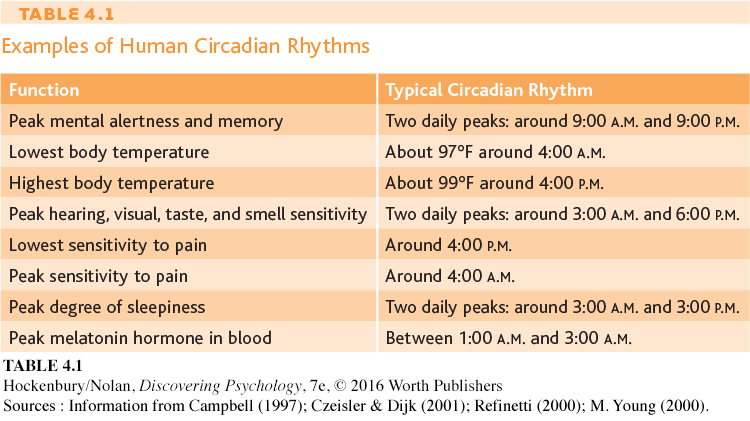Biological and Environmental “Clocks” That Regulate Consciousness

The Emergence of Circadian Rhythms Consistent daily variations in movement, heart rate, and other variables are evident during the fifth month of gestation in the human fetus. After birth, the synchronization of infants’ circadian rhythms to a day–night cycle usually occurs by 2 or 3 months of age (Mistlberger & Rusak, 2005). Daytime exposure to bright light helps establish these regular rest–activity circadian rhythms.
Camille Tokerud/Getty Images
Many body functions, including mental alertness, are regulated by circadian rhythms, which systematically vary over a 24-hour period.
How do light, the suprachiasmatic nucleus, and melatonin regulate the sleep-wake cycle?
What is jet lag, and what causes it?
Throughout the course of each day, consciousness ebbs and flows in a natural rhythm. Along with our daily cycle of wakefulness and sleep, researchers have identified more than 100 processes that rhythmically peak and dip at consistent times each day. These variations in physiological or behavioral activities are called circadian rhythms. The word circadian combines the Latin words for “about” and “day.” So, the term circadian rhythm refers to a biological or psychological process that systematically varies over the course of each day. Table 4.1 lists examples of circadian rhythms.
Page 138

SOURCES: Information from Campbell (1997); Czeisler & Dijk (2001); Refinetti (2000); M. Young (2000).
The Suprachiasmatic Nucleus
Your many circadian rhythms are controlled by a master biological clock—a tiny cluster of neurons in the hypothalamus in the brain. This cluster of neurons is called the suprachiasmatic nucleus, abbreviated SCN (see Figure 4.2). The SCN is the internal pacemaker that governs the timing of circadian rhythms, including the sleep—wake cycle.

FIGURE 4.2 The Biological Clock Special photoreceptors in the retina regulate the effects of light on the body’s circadian rhythms (Menaker, 2003). In response to morning light, signals from these special photoreceptors are relayed via the optic nerve to the suprachiasmatic nucleus. In turn, the suprachiasmatic nucleus reduces the pineal gland’s production of melatonin, a hormone that causes sleepiness. As blood levels of melatonin decrease, mental alertness increases. Daily exposure to bright light, especially sunlight, helps keep the body’s circadian rhythms synchronized and operating on a 24-hour schedule.
Image Source/ Punchstock

Want to Sleep Better? Turn Off That Screen! Smartphone, tablet, and laptop screens all emit blue light, which mimics daylight, increasing alertness and suppressing melatonin. A recent study by Anne-Marie Chang and her colleagues (2015) compared the effects of reading a print book with reading a light-emitting e-book two hours before bedtime. They found that the e-book readers took longer to fall asleep, had disrupted sleep patterns, and were less alert the next day than the print book readers. Melatonin production was also lower in the e-book users.
leungchopan/Shutterstock
Environmental cues are also involved in keeping the circadian rhythms synchronized. The most important of these cues is bright light, especially sunlight, but exposure to artificial light, including that generated by computer or tablet screens, also influences circadian rhythms (Dijk & others, 2012; Münch & others, 2012). In humans, light detected by special photoreceptors in the eye sends signals via the optic nerve to the SCN in the hypothalamus (Drouyer & others, 2007).
As the sun sets, the decrease in available light is detected by the SCN through its connections with the visual system. In turn, the SCN triggers an increase in the production of a hormone called melatonin. Melatonin is manufactured by the pineal gland, an endocrine gland located in the brain.
Increased blood levels of melatonin help make you sleepy and reduce activity levels. Blood levels of melatonin rise at night, peaking between 1:00 and 3:00 A.M. Shortly before sunrise, the pineal gland all but stops producing melatonin, and you soon wake up. As the sun rises, exposure to sunlight and other bright light suppresses melatonin levels, and they remain very low throughout the day. In this way, sunlight regulates, or entrains, the SCN so that it keeps your circadian cycles synchronized and operating on a 24-hour schedule.

FIGURE 4.1(B) Take a close look. Is your card missing? If so, we correctly identified the card you chose! Did we successfully read your mind? Or could there be another explanation? If you can’t figure out how we performed this magic trick, you can find the solution on page 177.
Reproduced with permission. Copyright © 2008 Scientific American, a division of Nature America, Inc. All rights reserved.
Page 139
In the absence of external time cues, our internal body clock drifts to its natural— or intrinsic—rhythm. Interestingly, our intrinsic circadian rhythm is about 24.2 hours, or slightly longer than a day (Czeisler & Gooley, 2007). When there are no external time cues, our normally coordinated circadian rhythms become desynchronized.
Exposure to environmental time signals is necessary for us to stay precisely synchronized, or entrained, to a 24-hour day. When environmental signals are out of sync with your internal body clock, such as when you travel and cross multiple time zones, you may experience symptoms of jet lag. You experience physical and mental fatigue, confusion or problems concentrating, depression or irritability, and disrupted sleep (Eastman & others, 2005). For many people, it can take up to a week or longer to readjust to an extreme time change. People who work the night shift or swing shift can also experience jet lag symptoms.

Circadian Rhythms and People Who Are Blind This college student, who has been blind since birth, confidently navigates her college campus with the help of her guide dog. Many people with total blindness have desynchronized circadian rhythms because they’re unable to detect the sunlight that normally sets the body’s internal biological clock, the SCN. Like sighted people deprived of all environmental time cues, blind people can experience desynchronized melatonin, body temperature, and sleep–wake circadian cycles. Consequently, about 60 percent of blind people suffer from recurring bouts of insomnia and other sleep problems (Arendt & others, 2005; Mistlberger & Skene, 2005).
Tony Savino/The Image Works
Test your understanding of Consciousness and Biological Clocks with  .
.






 .
.